Citroen C CROSSER 2008 1.G Owner's Manual
Manufacturer: CITROEN, Model Year: 2008, Model line: C CROSSER, Model: Citroen C CROSSER 2008 1.GPages: 216, PDF Size: 4.85 MB
Page 161 of 216
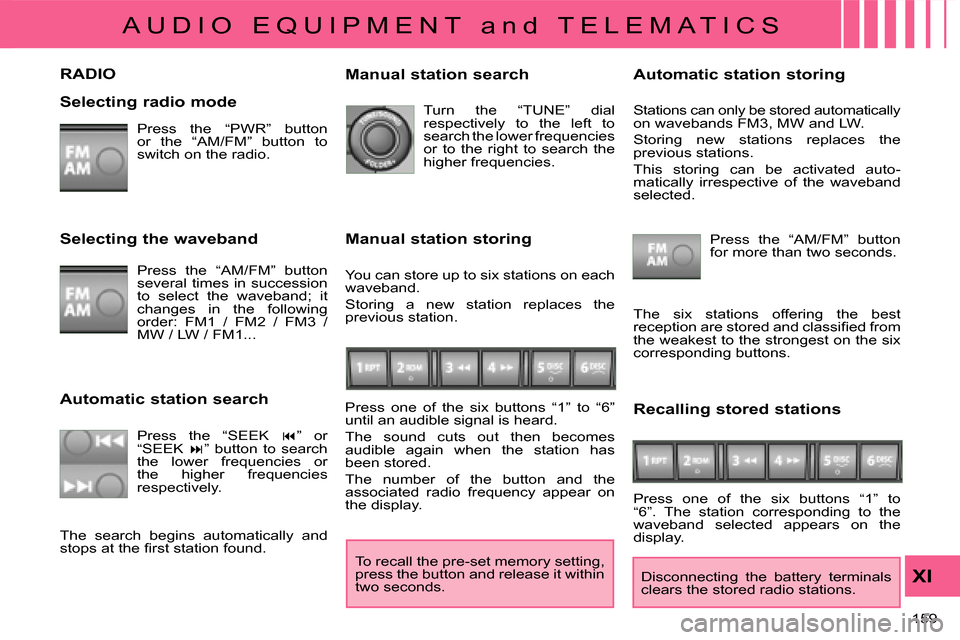
A U D I O E Q U I P M E N T a n d T E L E M A T I C S
XI
159
RADIO
Selecting radio mode Press the “PWR” button
or the “AM/FM” button to
switch on the radio.
Disconnecting the battery terminals
clears the stored radio stations.
Selecting the waveband
Press the “AM/FM” button
several times in succession
to select the waveband; it
changes in the following
order: FM1 / FM2 / FM3 /
MW / LW / FM1...
Automatic station search Press the “SEEK �� ” or
“SEEK � ” button to search
the lower frequencies or
the higher frequencies
respectively. Manual station search
Turn the “TUNE” dial
respectively to the left to
search the lower frequencies
or to the right to search the
higher frequencies.
Manual station storing
� �P�r�e�s�s� �o�n�e� �o�f� �t�h�e� �s�i�x� �b�u�t�t�o�n�s� �“�1�”� �t�o� �“�6�”�
until an audible signal is heard.
The sound cuts out then becomes
audible again when the station has
been stored.
The number of the button and the
associated radio frequency appear on
the display. Automatic station storing
Press the “AM/FM” button
for more than two seconds.
Recalling stored stations
� �P�r�e�s�s� �o�n�e� �o�f� �t�h�e� �s�i�x� �b�u�t�t�o�n�s� �“�1�”� �t�o�
“6”. The station corresponding to the
waveband selected appears on the
display.
The search begins automatically and
�s�t�o�p�s� �a�t� �t�h�e� �fi� �r�s�t� �s�t�a�t�i�o�n� �f�o�u�n�d�.� � � �T�h�e� �s�i�x� �s�t�a�t�i�o�n�s� �o�f�f�e�r�i�n�g� �t�h�e� �b�e�s�t�
�r�e�c�e�p�t�i�o�n� �a�r�e� �s�t�o�r�e�d� �a�n�d� �c�l�a�s�s�i�fi� �e�d� �f�r�o�m�
�t�h�e� �w�e�a�k�e�s�t� �t�o� �t�h�e� �s�t�r�o�n�g�e�s�t� �o�n� �t�h�e� �s�i�x�
corresponding buttons.
� �Y�o�u� �c�a�n� �s�t�o�r�e� �u�p� �t�o� �s�i�x� �s�t�a�t�i�o�n�s� �o�n� �e�a�c�h�
waveband.
Storing a new station replaces the
previous station. Stations can only be stored automatically
on wavebands FM3, MW and LW.
Storing new stations replaces the
previous stations.
This storing can be activated auto-
matically irrespective of the waveband
selected.
To recall the pre-set memory setting,
press the button and release it within
two seconds.
Page 162 of 216
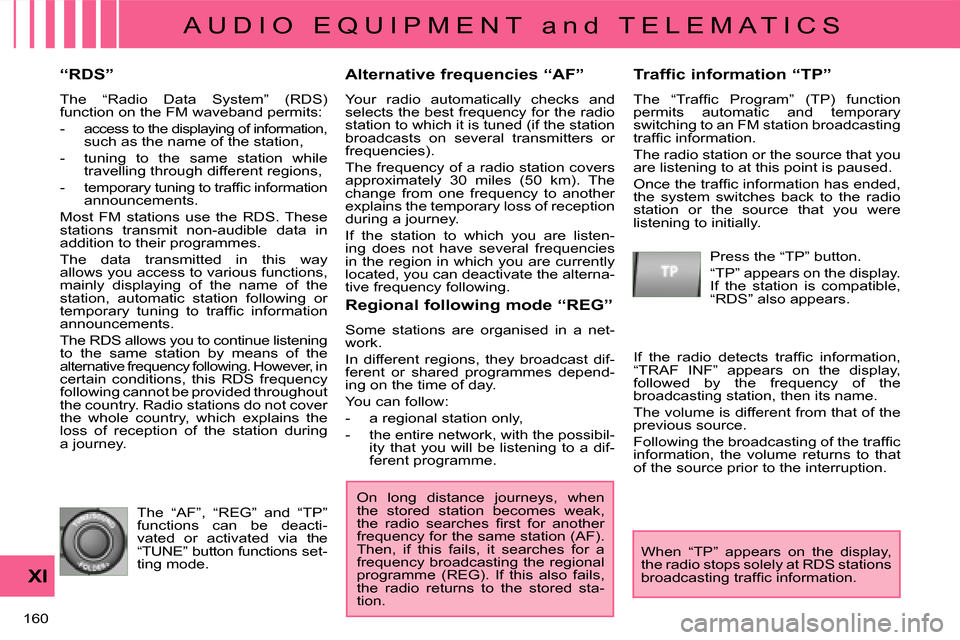
A U D I O E Q U I P M E N T a n d T E L E M A T I C S
XI
160
“RDS”
The “Radio Data System” (RDS)
function on the FM waveband permits:
- access to the displaying of information, such as the name of the station,
- tuning to the same station while travelling through different regions,
� � �-� � �t�e�m�p�o�r�a�r�y� �t�u�n�i�n�g� �t�o� �t�r�a�f�fi� �c� �i�n�f�o�r�m�a�t�i�o�n� announcements.
Most FM stations use the RDS. These
stations transmit non-audible data in
addition to their programmes.
The data transmitted in this way
allows you access to various functions,
mainly displaying of the name of the
station, automatic station following or
�t�e�m�p�o�r�a�r�y� �t�u�n�i�n�g� �t�o� �t�r�a�f�fi� �c� �i�n�f�o�r�m�a�t�i�o�n�
announcements.
The RDS allows you to continue listening
to the same station by means of the
alternative frequency following. However, in
certain conditions, this RDS frequency
following cannot be provided throughout
the country. Radio stations do not cover
�t�h�e� �w�h�o�l�e� �c�o�u�n�t�r�y�,� �w�h�i�c�h� �e�x�p�l�a�i�n�s� �t�h�e�
loss of reception of the station during
a journey. Alternative frequencies “AF”
Your radio automatically checks and
selects the best frequency for the radio
station to which it is tuned (if the station
broadcasts on several transmitters or
frequencies).
The frequency of a radio station covers
�a�p�p�r�o�x�i�m�a�t�e�l�y� �3�0� �m�i�l�e�s� �(�5�0� �k�m�)�.� �T�h�e�
change from one frequency to another
�e�x�p�l�a�i�n�s� �t�h�e� �t�e�m�p�o�r�a�r�y� �l�o�s�s� �o�f� �r�e�c�e�p�t�i�o�n�
during a journey.
If the station to which you are listen-
ing does not have several frequencies
in the region in which you are currently
located, you can deactivate the alterna-
tive frequency following.
Traffic information “TP”
� �T�h�e� �“�T�r�a�f�fi� �c� �P�r�o�g�r�a�m�”� �(�T�P�)� �f�u�n�c�t�i�o�n�
permits automatic and temporary
switching to an FM station broadcasting
�t�r�a�f�fi� �c� �i�n�f�o�r�m�a�t�i�o�n�.�
The radio station or the source that you
are listening to at this point is paused.
� �O�n�c�e� �t�h�e� �t�r�a�f�fi� �c� �i�n�f�o�r�m�a�t�i�o�n� �h�a�s� �e�n�d�e�d�,�
the system switches back to the radio
station or the source that you were
listening to initially.
Regional following mode “REG”
Some stations are organised in a net-
work.
In different regions, they broadcast dif-
ferent or shared programmes depend-
ing on the time of day.
You can follow:
- a regional station only,
- the entire network, with the possibil- ity that you will be listening to a dif-
ferent programme.
The “AF”, “REG” and “TP”
functions can be deacti-
vated or activated via the
“TUNE” button functions set-
ting mode. Press the “TP” button.
“TP” appears on the display.
If the station is compatible,
“RDS” also appears.
� �I�f� �t�h�e� �r�a�d�i�o� �d�e�t�e�c�t�s� �t�r�a�f�fi� �c� �i�n�f�o�r�m�a�t�i�o�n�,�
“TRAF INF” appears on the display,
followed by the frequency of the
broadcasting station, then its name.
The volume is different from that of the
previous source.
� �F�o�l�l�o�w�i�n�g� �t�h�e� �b�r�o�a�d�c�a�s�t�i�n�g� �o�f� �t�h�e� �t�r�a�f�fi� �c�
information, the volume returns to that
of the source prior to the interruption.
When “TP” appears on the display,
the radio stops solely at RDS stations
�b�r�o�a�d�c�a�s�t�i�n�g� �t�r�a�f�fi� �c� �i�n�f�o�r�m�a�t�i�o�n�.� �
On long distance journeys, when
the stored station becomes weak,
�t�h�e� �r�a�d�i�o� �s�e�a�r�c�h�e�s� �fi� �r�s�t� �f�o�r� �a�n�o�t�h�e�r�
frequency for the same station (AF).
Then, if this fails, it searches for a
frequency broadcasting the regional
programme (REG). If this also fails,
the radio returns to the stored sta-
tion.
Page 163 of 216
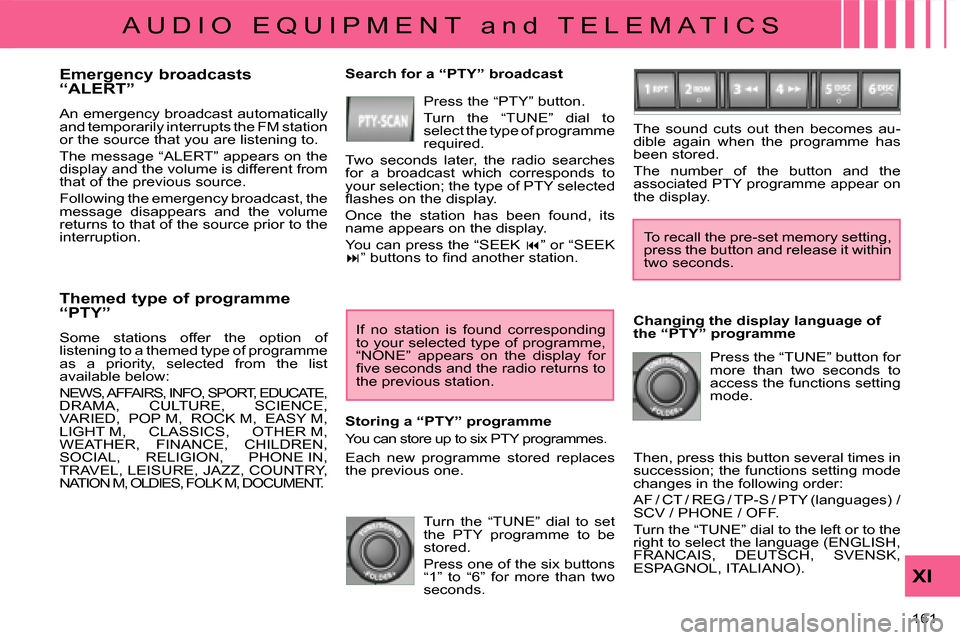
A U D I O E Q U I P M E N T a n d T E L E M A T I C S
XI
161
Themed type of programme
“PTY”
Some stations offer the option of
listening to a themed type of programme
as a priority, selected from the list
available below:
NEWS, AFFAIRS, INFO, SPORT, EDUCATE,
DRAMA, CULTURE, SCIENCE,
VARIED, POP M, ROCK M, EASY M,
LIGHT M, CLASSICS, OTHER M,
WEATHER, FINANCE, CHILDREN,
SOCIAL, RELIGION, PHONE IN,
TRAVEL, LEISURE, JAZZ, COUNTRY,
NATION M, OLDIES, FOLK M, DOCUMENT.
Emergency broadcasts
“ALERT”
An emergency broadcast automatically
and temporarily interrupts the FM station
or the source that you are listening to.
The message “ALERT” appears on the
display and the volume is different from
that of the previous source.
Following the emergency broadcast, the
message disappears and the volume
returns to that of the source prior to the
interruption.
Search for a “PTY” broadcast
Press the “PTY” button.
Turn the “TUNE” dial to
select the type of programme
required.
Two seconds later, the radio searches
for a broadcast which corresponds to
your selection; the type of PTY selected
�fl� �a�s�h�e�s� �o�n� �t�h�e� �d�i�s�p�l�a�y�.�
Once the station has been found, its
name appears on the display.
You can press the “SEEK � ” or “SEEK
� � �”� �b�u�t�t�o�n�s� �t�o� �fi� �n�d� �a�n�o�t�h�e�r� �s�t�a�t�i�o�n�.�
If no station is found corresponding
to your selected type of programme,
“NONE” appears on the display for
�fi� �v�e� �s�e�c�o�n�d�s� �a�n�d� �t�h�e� �r�a�d�i�o� �r�e�t�u�r�n�s� �t�o�
the previous station.
Each new programme stored replaces
the previous one.
Storing a “PTY” programme
� �Y�o�u� �c�a�n� �s�t�o�r�e� �u�p� �t�o� �s�i�x� �P�T�Y� �p�r�o�g�r�a�m�m�e�s�.� To recall the pre-set memory setting,
press the button and release it within
two seconds.
Changing the display language of
the “PTY” programme Press the “TUNE” button for
more than two seconds to
access the functions setting
mode.
Then, press this button several times in
succession; the functions setting mode
changes in the following order:
AF / CT / REG / TP-S / PTY (languages) /
SCV / PHONE / OFF.
Turn the “TUNE” dial to the left or to the
right to select the language (ENGLISH,
FRANCAIS, DEUTSCH, SVENSK,
ESPAGNOL, ITALIANO).
The sound cuts out then becomes au-
dible again when the programme has
been stored.
The number of the button and the
associated PTY programme appear on
the display.
Turn the “TUNE” dial to set
the PTY programme to be
stored.
� �P�r�e�s�s� �o�n�e� �o�f� �t�h�e� �s�i�x� �b�u�t�t�o�n�s�
“1” to “6” for more than two
seconds.
Page 164 of 216
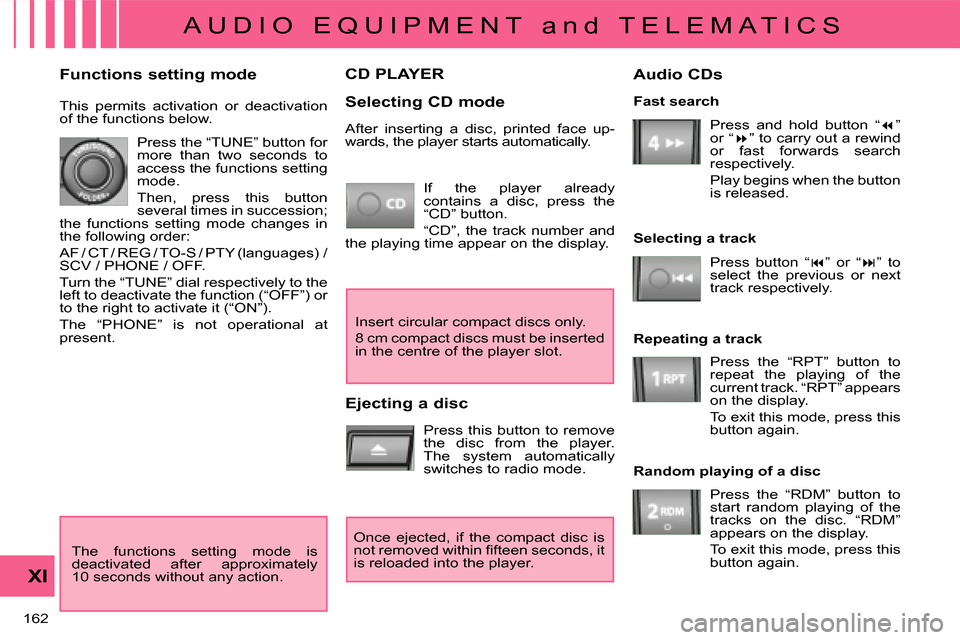
A U D I O E Q U I P M E N T a n d T E L E M A T I C S
XI
162
CD PLAYER
Selecting CD mode If the player already
contains a disc, press the
“CD” button.
“CD”, the track number and
the playing time appear on the display.
Functions setting mode
This permits activation or deactivation
of the functions below.
Press the “TUNE” button for
more than two seconds to
access the functions setting
mode.
Then, press this button
several times in succession;
the functions setting mode changes in
the following order:
AF / CT / REG / TO-S / PTY (languages) /
SCV / PHONE / OFF.
Turn the “TUNE” dial respectively to the
left to deactivate the function (“OFF”) or
to the right to activate it (“ON”).
The “PHONE” is not operational at
present.
The functions setting mode is
�d�e�a�c�t�i�v�a�t�e�d� �a�f�t�e�r� �a�p�p�r�o�x�i�m�a�t�e�l�y�
10 seconds without any action. After inserting a disc, printed face up-
wards, the player starts automatically.
Ejecting a disc
Press this button to remove
the disc from the player.
The system automatically
switches to radio mode. Fast search
�
�
Press and hold button “ � ”
or “ � ” to carry out a rewind
or fast forwards search
respectively.
Play begins when the button
is released.
Selecting a track
�
�
Press button “ � ” or “ � ” to
�s�e�l�e�c�t� �t�h�e� �p�r�e�v�i�o�u�s� �o�r� �n�e�x�t�
track respectively.
Repeating a track Press the “RPT” button to
repeat the playing of the
current track. “RPT” appears
on the display.
� �T�o� �e�x�i�t� �t�h�i�s� �m�o�d�e�,� �p�r�e�s�s� �t�h�i�s�
button again.
Random playing of a disc Press the “RDM” button to
start random playing of the
tracks on the disc. “RDM”
appears on the display.
� �T�o� �e�x�i�t� �t�h�i�s� �m�o�d�e�,� �p�r�e�s�s� �t�h�i�s�
button again.
Insert circular compact discs only.
8 cm compact discs must be inserted
in the centre of the player slot.
Once ejected, if the compact disc is
�n�o�t� �r�e�m�o�v�e�d� �w�i�t�h�i�n� �fi� �f�t�e�e�n� �s�e�c�o�n�d�s�,� �i�t�
is reloaded into the player. Audio CDs
Page 165 of 216
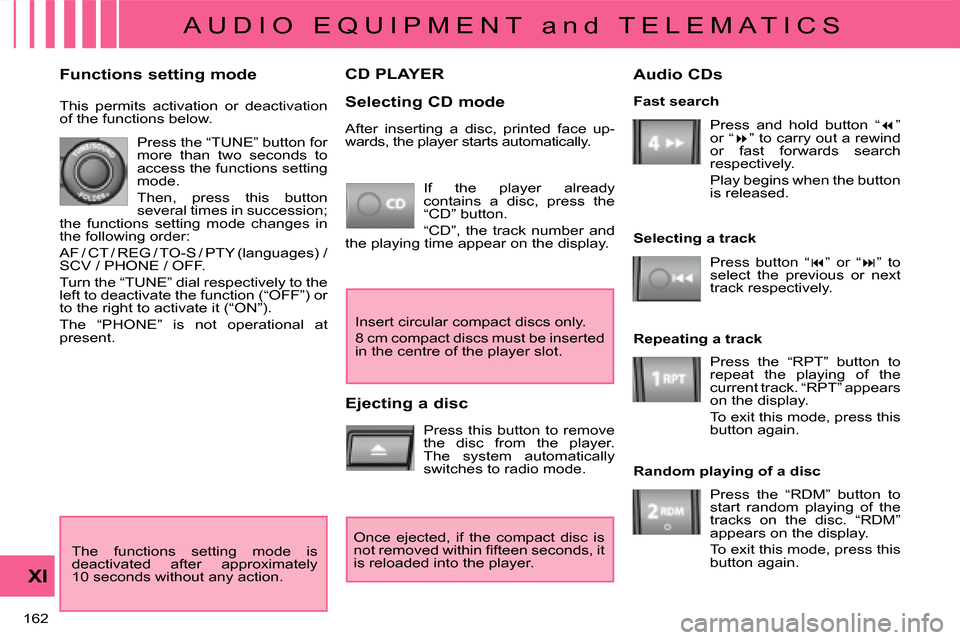
A U D I O E Q U I P M E N T a n d T E L E M A T I C S
XI
162
CD PLAYER
Selecting CD mode If the player already
contains a disc, press the
“CD” button.
“CD”, the track number and
the playing time appear on the display.
Functions setting mode
This permits activation or deactivation
of the functions below.
Press the “TUNE” button for
more than two seconds to
access the functions setting
mode.
Then, press this button
several times in succession;
the functions setting mode changes in
the following order:
AF / CT / REG / TO-S / PTY (languages) /
SCV / PHONE / OFF.
Turn the “TUNE” dial respectively to the
left to deactivate the function (“OFF”) or
to the right to activate it (“ON”).
The “PHONE” is not operational at
present.
The functions setting mode is
�d�e�a�c�t�i�v�a�t�e�d� �a�f�t�e�r� �a�p�p�r�o�x�i�m�a�t�e�l�y�
10 seconds without any action. After inserting a disc, printed face up-
wards, the player starts automatically.
Ejecting a disc
Press this button to remove
the disc from the player.
The system automatically
switches to radio mode. Fast search
�
�
Press and hold button “ � ”
or “ � ” to carry out a rewind
or fast forwards search
respectively.
Play begins when the button
is released.
Selecting a track
�
�
Press button “ � ” or “ � ” to
�s�e�l�e�c�t� �t�h�e� �p�r�e�v�i�o�u�s� �o�r� �n�e�x�t�
track respectively.
Repeating a track Press the “RPT” button to
repeat the playing of the
current track. “RPT” appears
on the display.
� �T�o� �e�x�i�t� �t�h�i�s� �m�o�d�e�,� �p�r�e�s�s� �t�h�i�s�
button again.
Random playing of a disc Press the “RDM” button to
start random playing of the
tracks on the disc. “RDM”
appears on the display.
� �T�o� �e�x�i�t� �t�h�i�s� �m�o�d�e�,� �p�r�e�s�s� �t�h�i�s�
button again.
Insert circular compact discs only.
8 cm compact discs must be inserted
in the centre of the player slot.
Once ejected, if the compact disc is
�n�o�t� �r�e�m�o�v�e�d� �w�i�t�h�i�n� �fi� �f�t�e�e�n� �s�e�c�o�n�d�s�,� �i�t�
is reloaded into the player. Audio CDs
Page 166 of 216
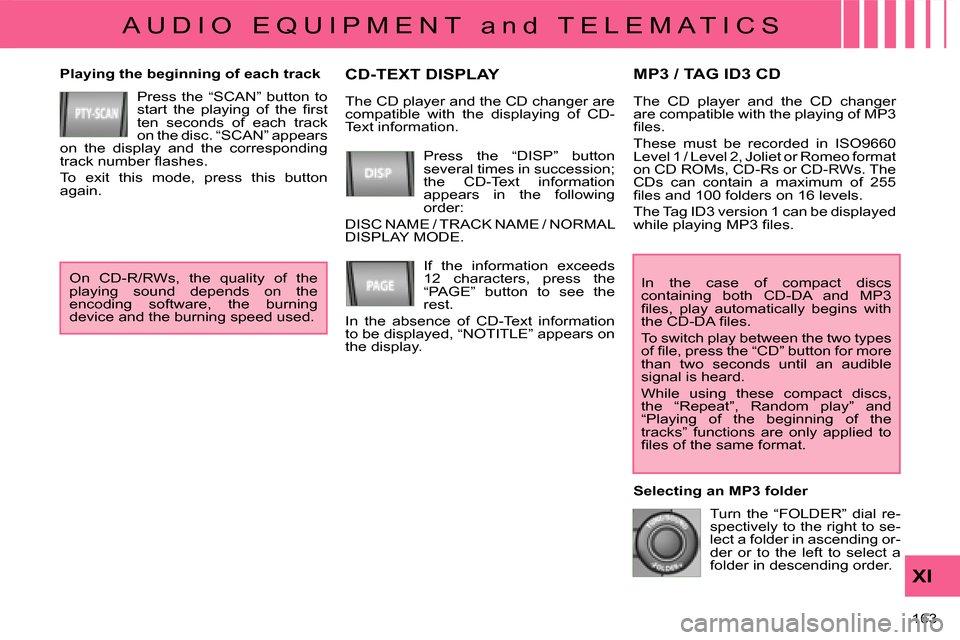
A U D I O E Q U I P M E N T a n d T E L E M A T I C S
XI
163
MP3 / TAG ID3 CD Playing the beginning of each track Press the “SCAN” button to
�s�t�a�r�t� �t�h�e� �p�l�a�y�i�n�g� �o�f� �t�h�e� �fi� �r�s�t�
ten seconds of each track
on the disc. “SCAN” appears
on the display and the corresponding
�t�r�a�c�k� �n�u�m�b�e�r� �fl� �a�s�h�e�s�.�
� �T�o� �e�x�i�t� �t�h�i�s� �m�o�d�e�,� �p�r�e�s�s� �t�h�i�s� �b�u�t�t�o�n�
again. The CD player and the CD changer
are compatible with the playing of MP3
�fi� �l�e�s�.�
These must be recorded in ISO9660
Level 1 / Level 2, Joliet or Romeo format
on CD ROMs, CD-Rs or CD-RWs. The
�C�D�s� �c�a�n� �c�o�n�t�a�i�n� �a� �m�a�x�i�m�u�m� �o�f� �2�5�5�
�fi� �l�e�s� �a�n�d� �1�0�0� �f�o�l�d�e�r�s� �o�n� �1�6� �l�e�v�e�l�s�.�
The Tag ID3 version 1 can be displayed
�w�h�i�l�e� �p�l�a�y�i�n�g� �M�P�3� �fi� �l�e�s�.�
In the case of compact discs
containing both CD-DA and MP3
�fi� �l�e�s�,� �p�l�a�y� �a�u�t�o�m�a�t�i�c�a�l�l�y� �b�e�g�i�n�s� �w�i�t�h�
�t�h�e� �C�D�-�D�A� �fi� �l�e�s�.�
To switch play between the two types
�o�f� �fi� �l�e�,� �p�r�e�s�s� �t�h�e� �“�C�D�”� �b�u�t�t�o�n� �f�o�r� �m�o�r�e�
than two seconds until an audible
signal is heard.
While using these compact discs,
the “Repeat”, Random play” and
“Playing of the beginning of the
tracks” functions are only applied to
�fi� �l�e�s� �o�f� �t�h�e� �s�a�m�e� �f�o�r�m�a�t�.� �
Selecting an MP3 folder Turn the “FOLDER” dial re-
spectively to the right to se-
lect a folder in ascending or-
der or to the left to select a
folder in descending order.
Press the “DISP” button
several times in succession;
�t�h�e� �C�D�-�T�e�x�t� �i�n�f�o�r�m�a�t�i�o�n�
appears in the following
order:
DISC NAME / TRACK NAME / NORMAL
DISPLAY MODE. CD-TEXT DISPLAY
� �I�f� �t�h�e� �i�n�f�o�r�m�a�t�i�o�n� �e�x�c�e�e�d�s�
12 characters, press the
“PAGE” button to see the
rest.
� �I�n� �t�h�e� �a�b�s�e�n�c�e� �o�f� �C�D�-�T�e�x�t� �i�n�f�o�r�m�a�t�i�o�n�
to be displayed, “NOTITLE” appears on
the display.
The CD player and the CD changer are
compatible with the displaying of CD-
�T�e�x�t� �i�n�f�o�r�m�a�t�i�o�n�.�
On CD-R/RWs, the quality of the
playing sound depends on the
encoding software, the burning
device and the burning speed used.
Page 167 of 216
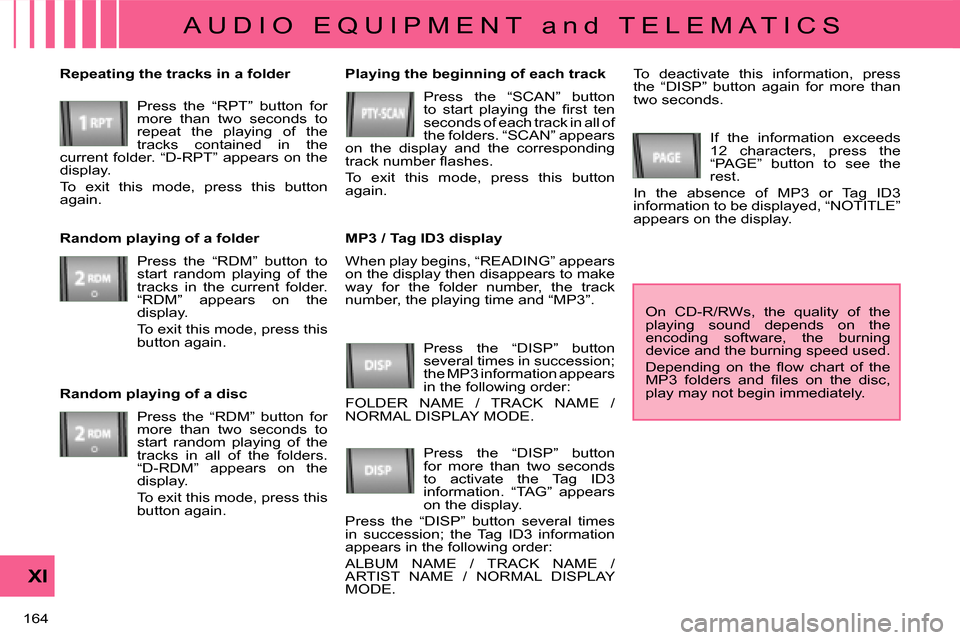
A U D I O E Q U I P M E N T a n d T E L E M A T I C S
XI
164
When play begins, “READING” appears
on the display then disappears to make
way for the folder number, the track
number, the playing time and “MP3”.
Playing the beginning of each track
Press the “SCAN” button
�t�o� �s�t�a�r�t� �p�l�a�y�i�n�g� �t�h�e� �fi� �r�s�t� �t�e�n�
seconds of each track in all of
the folders. “SCAN” appears
on the display and the corresponding
�t�r�a�c�k� �n�u�m�b�e�r� �fl� �a�s�h�e�s�.�
� �T�o� �e�x�i�t� �t�h�i�s� �m�o�d�e�,� �p�r�e�s�s� �t�h�i�s� �b�u�t�t�o�n�
again.
MP3 / Tag ID3 display
Press the “DISP” button
several times in succession;
the MP3 information appears
in the following order:
FOLDER NAME / TRACK NAME /
NORMAL DISPLAY MODE. � �I�f� �t�h�e� �i�n�f�o�r�m�a�t�i�o�n� �e�x�c�e�e�d�s�
12 characters, press the
“PAGE” button to see the
rest.
In the absence of MP3 or Tag ID3
information to be displayed, “NOTITLE”
appears on the display.
Press the “DISP” button
for more than two seconds
to activate the Tag ID3
information. “TAG” appears
on the display.
Press the “DISP” button several times
in succession; the Tag ID3 information
appears in the following order:
ALBUM NAME / TRACK NAME /
ARTIST NAME / NORMAL DISPLAY
MODE. To deactivate this information, press
the “DISP” button again for more than
two seconds.
Repeating the tracks in a folder
Press the “RPT” button for
more than two seconds to
repeat the playing of the
tracks contained in the
current folder. “D-RPT” appears on the
display.
� �T�o� �e�x�i�t� �t�h�i�s� �m�o�d�e�,� �p�r�e�s�s� �t�h�i�s� �b�u�t�t�o�n�
again.
Random playing of a folder
Press the “RDM” button to
start random playing of the
tracks in the current folder.
“RDM” appears on the
display.
� �T�o� �e�x�i�t� �t�h�i�s� �m�o�d�e�,� �p�r�e�s�s� �t�h�i�s�
button again.
Random playing of a disc Press the “RDM” button for
more than two seconds to
start random playing of the
tracks in all of the folders.
“D-RDM” appears on the
display.
� �T�o� �e�x�i�t� �t�h�i�s� �m�o�d�e�,� �p�r�e�s�s� �t�h�i�s�
button again. On CD-R/RWs, the quality of the
playing sound depends on the
encoding software, the burning
device and the burning speed used.
� �D�e�p�e�n�d�i�n�g� �o�n� �t�h�e� �fl� �o�w� �c�h�a�r�t� �o�f� �t�h�e�
�M�P�3� �f�o�l�d�e�r�s� �a�n�d� �fi� �l�e�s� �o�n� �t�h�e� �d�i�s�c�,�
play may not begin immediately.
Page 168 of 216
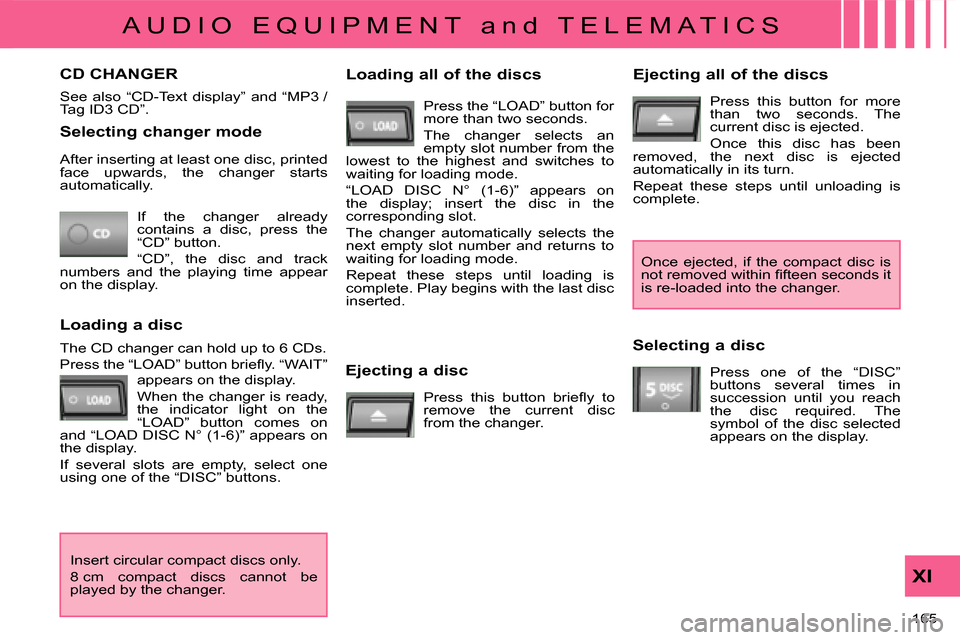
A U D I O E Q U I P M E N T a n d T E L E M A T I C S
XI
165
Selecting changer mode If the changer already
contains a disc, press the
“CD” button.
“CD”, the disc and track
numbers and the playing time appear
on the display.
After inserting at least one disc, printed
face upwards, the changer starts
automatically.
Ejecting a disc � �P�r�e�s�s� �t�h�i�s� �b�u�t�t�o�n� �b�r�i�e�fl� �y� �t�o�
remove the current disc
from the changer. Once ejected, if the compact disc is
�n�o�t� �r�e�m�o�v�e�d� �w�i�t�h�i�n� �fi� �f�t�e�e�n� �s�e�c�o�n�d�s� �i�t�
is re-loaded into the changer.
Loading a disc
appears on the display.
When the changer is ready,
the indicator light on the
“LOAD” button comes on
and “LOAD DISC N° (1-6)” appears on
the display.
If several slots are empty, select one
using one of the “DISC” buttons.
The CD changer can hold up to 6 CDs.
� �P�r�e�s�s� �t�h�e� �“�L�O�A�D�”� �b�u�t�t�o�n� �b�r�i�e�fl� �y�.� �“�W�A�I�T�”�
Insert circular compact discs only.
8 cm compact discs cannot be
played by the changer. Loading all of the discs Ejecting all of the discs
Press this button for more
than two seconds. The
current disc is ejected.
Once this disc has been
�r�e�m�o�v�e�d�,� �t�h�e� �n�e�x�t� �d�i�s�c� �i�s� �e�j�e�c�t�e�d�
automatically in its turn.
Repeat these steps until unloading is
complete.
Selecting a disc Press one of the “DISC”
buttons several times in
succession until you reach
the disc required. The
symbol of the disc selected
appears on the display.
� �S�e�e� �a�l�s�o� �“�C�D�-�T�e�x�t� �d�i�s�p�l�a�y�”� �a�n�d� �“�M�P�3� �/�
Tag ID3 CD”.
Press the “LOAD” button for
more than two seconds.
The changer selects an
empty slot number from the
lowest to the highest and switches to
waiting for loading mode.
“LOAD DISC N° (1-6)” appears on
the display; insert the disc in the
corresponding slot.
The changer automatically selects the
�n�e�x�t� �e�m�p�t�y� �s�l�o�t� �n�u�m�b�e�r� �a�n�d� �r�e�t�u�r�n�s� �t�o�
waiting for loading mode.
Repeat these steps until loading is
complete. Play begins with the last disc
inserted.
CD CHANGER
Page 169 of 216
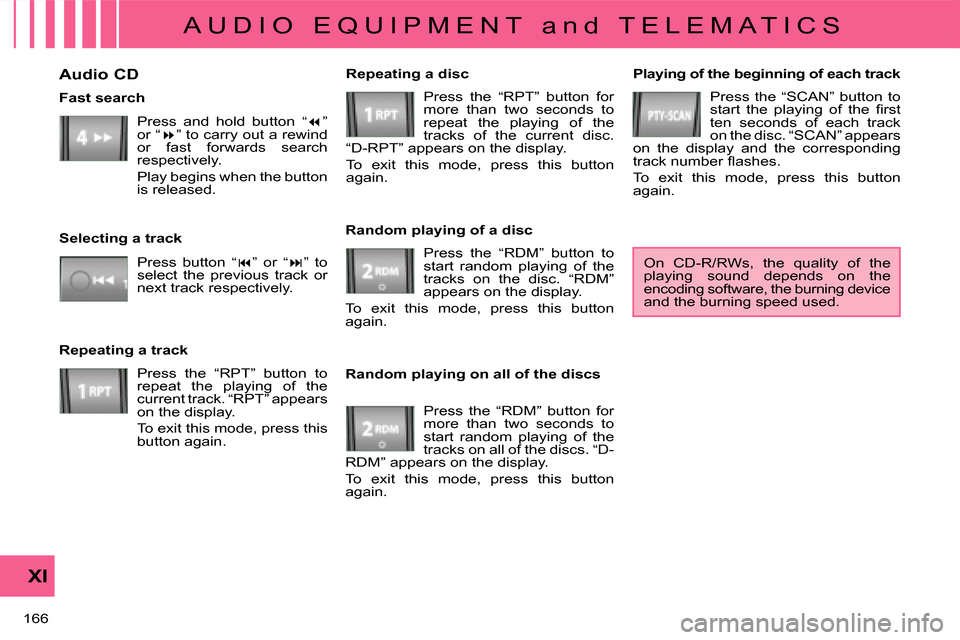
A U D I O E Q U I P M E N T a n d T E L E M A T I C S
XI
166
Playing of the beginning of each track Press the “SCAN” button to
�s�t�a�r�t� �t�h�e� �p�l�a�y�i�n�g� �o�f� �t�h�e� �fi� �r�s�t�
ten seconds of each track
on the disc. “SCAN” appears
on the display and the corresponding
�t�r�a�c�k� �n�u�m�b�e�r� �fl� �a�s�h�e�s�.�
� �T�o� �e�x�i�t� �t�h�i�s� �m�o�d�e�,� �p�r�e�s�s� �t�h�i�s� �b�u�t�t�o�n�
again.
On CD-R/RWs, the quality of the
playing sound depends on the
encoding software, the burning device
and the burning speed used.
Random playing on all of the discs Press the “RDM” button for
more than two seconds to
start random playing of the
tracks on all of the discs. “D-
RDM” appears on the display.
� �T�o� �e�x�i�t� �t�h�i�s� �m�o�d�e�,� �p�r�e�s�s� �t�h�i�s� �b�u�t�t�o�n�
again.
Fast search
Press and hold button “ �� ”
or “ � ” to carry out a rewind
or fast forwards search
respectively.
Play begins when the button
is released.
Selecting a track Press button “ �� ” or “ � ” to
select the previous track or
�n�e�x�t� �t�r�a�c�k� �r�e�s�p�e�c�t�i�v�e�l�y�.� �
Repeating a track Press the “RPT” button to
repeat the playing of the
current track. “RPT” appears
on the display.
� �T�o� �e�x�i�t� �t�h�i�s� �m�o�d�e�,� �p�r�e�s�s� �t�h�i�s�
button again. Random playing of a disc
Press the “RDM” button to
start random playing of the
tracks on the disc. “RDM”
appears on the display.
� �T�o� �e�x�i�t� �t�h�i�s� �m�o�d�e�,� �p�r�e�s�s� �t�h�i�s� �b�u�t�t�o�n�
again. Repeating a disc
Press the “RPT” button for
more than two seconds to
repeat the playing of the
tracks of the current disc.
“D-RPT” appears on the display.
� �T�o� �e�x�i�t� �t�h�i�s� �m�o�d�e�,� �p�r�e�s�s� �t�h�i�s� �b�u�t�t�o�n�
again.
Audio CD
Page 170 of 216
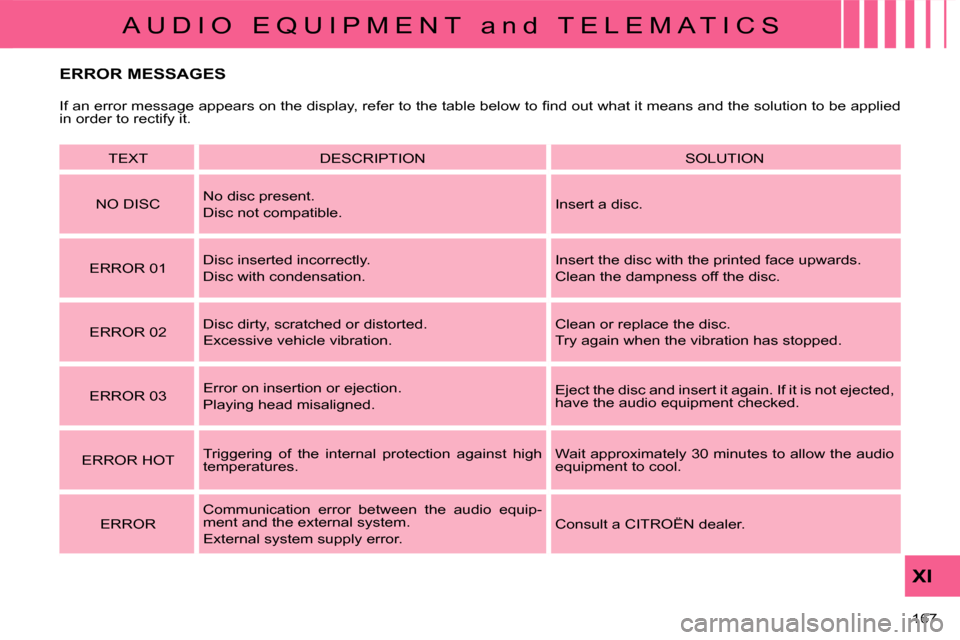
A U D I O E Q U I P M E N T a n d T E L E M A T I C S
XI
167
ERROR MESSAGES
� �I�f� �a�n� �e�r�r�o�r� �m�e�s�s�a�g�e� �a�p�p�e�a�r�s� �o�n� �t�h�e� �d�i�s�p�l�a�y�,� �r�e�f�e�r� �t�o� �t�h�e� �t�a�b�l�e� �b�e�l�o�w� �t�o� �fi� �n�d� �o�u�t� �w�h�a�t� �i�t� �m�e�a�n�s� �a�n�d� �t�h�e� �s�o�l�u�t�i�o�n� �t�o� �b�e� �a�p�p�l�i�e�d�
in order to rectify it.
TEXT DESCRIPTION SOLUTION
NO DISC No disc present.
Disc not compatible. Insert a disc.
ERROR 01 Disc inserted incorrectly.
Disc with condensation. Insert the disc with the printed face upwards.
Clean the dampness off the disc.
ERROR 02 Disc dirty, scratched or distorted.
�E�x�c�e�s�s�i�v�e� �v�e�h�i�c�l�e� �v�i�b�r�a�t�i�o�n�.� Clean or replace the disc.
Try again when the vibration has stopped.
ERROR 03 Error on insertion or ejection.
Playing head misaligned. Eject the disc and insert it again. If it is not ejected,
have the audio equipment checked.
ERROR HOT Triggering of the internal protection against high
temperatures. � �W�a�i�t� �a�p�p�r�o�x�i�m�a�t�e�l�y� �3�0� �m�i�n�u�t�e�s� �t�o� �a�l�l�o�w� �t�h�e� �a�u�d�i�o�
equipment to cool.
ERROR Communication error between the audio equip-
�m�e�n�t� �a�n�d� �t�h�e� �e�x�t�e�r�n�a�l� �s�y�s�t�e�m�.� �
�E�x�t�e�r�n�a�l� �s�y�s�t�e�m� �s�u�p�p�l�y� �e�r�r�o�r�.�
Consult a CITROËN dealer.